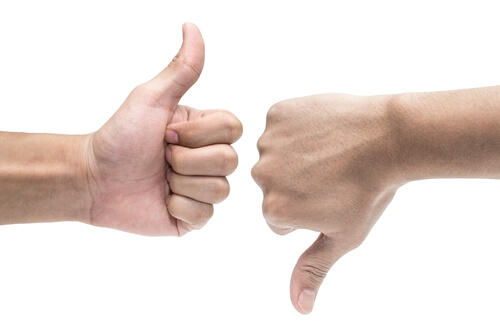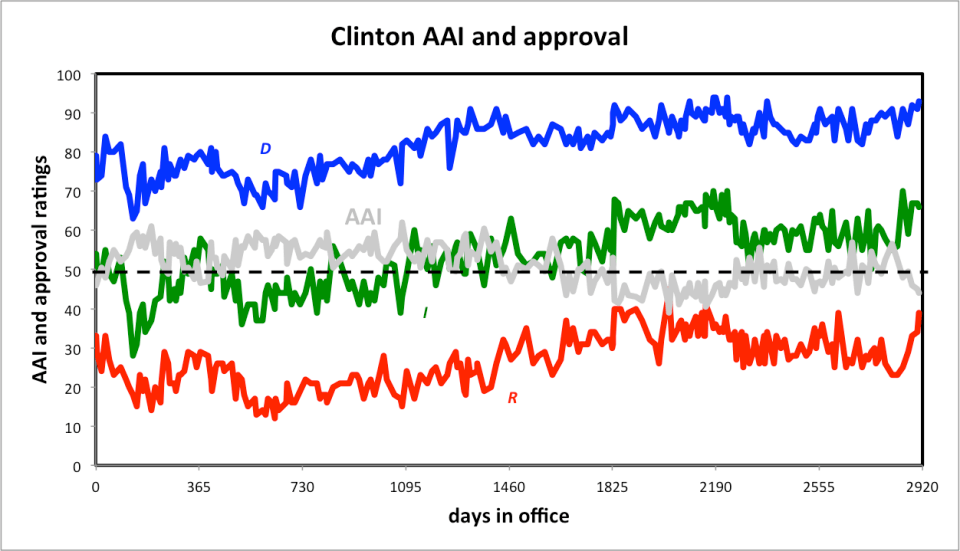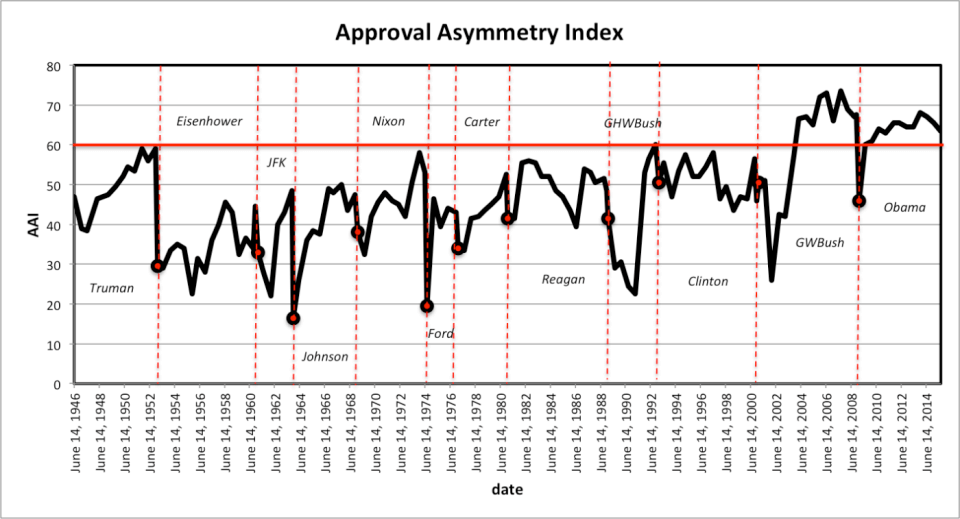Ricochet is the best place on the internet to discuss the issues of the day, either through commenting on posts or writing your own for our active and dynamic community in a fully moderated environment. In addition, the Ricochet Audio Network offers over 50 original podcasts with new episodes released every day.
 Are We Becoming More Polarized?
Are We Becoming More Polarized?
 For my first post on Ricochet, I would like to propose the Approval Asymmetry Index (AAI), a simple measure of political polarization. Based on the Gallup Presidential Approval poll, it combines the support of members of the incumbent’s party (A) with non-approval from the opposition (B) and independents (C), all equally weighted. The formula [AAI = 0.5 × (A-B-C+100)] produces a number between 0 and 100, with higher values suggesting a greater divergence of opinion. Complete polarization (AAI = 100) would represent 100 percent approval from the incumbent party with 0 percent approval from all others. A president beloved by all would earn an AAI of 0, there being no asymmetry.
For my first post on Ricochet, I would like to propose the Approval Asymmetry Index (AAI), a simple measure of political polarization. Based on the Gallup Presidential Approval poll, it combines the support of members of the incumbent’s party (A) with non-approval from the opposition (B) and independents (C), all equally weighted. The formula [AAI = 0.5 × (A-B-C+100)] produces a number between 0 and 100, with higher values suggesting a greater divergence of opinion. Complete polarization (AAI = 100) would represent 100 percent approval from the incumbent party with 0 percent approval from all others. A president beloved by all would earn an AAI of 0, there being no asymmetry.
It should be appreciated that AAI is does not reflect simple popularity and so may help reveal factors obscured by the simple approval ratings scores that are generally reported. Inspection of past polling data revealed two things to me. First, the in-party tends to support their guy come hell or high water and the out-party generally withholds support, with independents being somewhere in between. This has been true since Truman, when the Gallup poll ostensibly started. Second, the approvals and disapprovals for more recent presidents, notably George W. Bush and Barack Obama, struck me as being rather different. Why?
My proposed formula produces an AAI of 50 when the president has 75 percent support from his party, only 25 percent from the opposition, and independent approval is 50 percent. Those numbers are not far from the long-term, 12-president mean values of 78, 32, and 51% (AAI = 48), respectively, so let’s consider an AAI of 50 to be “normal,” or at least “business as usual.” AAIs under 50 can occur when incumbents are either broadly popular (Eisenhower) or unpopular (Carter), and I hypothesize that AAIs well above 60 indicate a very polarized electorate.

Time series of Democratic (D), Independent (I) and Republican (R) approvals for Bill Clinton’s presidency, along with AAI values.
To emphasize that AAI is not merely popularity itself, consider the chart above, showing Bill Clinton’s approval ratings and AAI during his presidency. These three measures were independent, but tended to move in unison. As a consequence, Clinton’s AAI (in grey) fluctuated through a relatively small range, and generally decreased through his two terms.
The second plot, below, shows how AAI has varied since the Gallup poll started. As noted earlier, presidents tend to start off with good wishes and relatively few doubters, which is why an incumbent’s first AAI is typically his lowest (though you can see the consequences of the first Gulf War and 9/11). Johnson’s and Ford’s initial AAIs were very low, reflecting the circumstances that brought them to the presidency. Until recently, AAIs exceeding 60 were quite rare, and short lived: Truman’s got to about 60 at the end of his tenure, as did Nixon’s right before he resigned. George H. W. Bush got close to 60 at the end of his term, and Clinton flirted with 60 during his first term, before he moderated his strategy.

Time series of AAI since the Gallup poll started during Truman’s first term.
However, after the shadow of 9/11 passed, George W. Bush’s approval asymmetry breached 60 and remained above it for the balance of his presidency. The highest AAI (77) from any poll available to me came during his second term, when only 6% of Democrats and 21% of Independents expressed approval, but 81 percent of Republicans did. That is incredibly asymmetric. Like his predecessors, Obama started with a lower AAI, but he, too, went north of 60 after a few months, as he pursued legislation such as Obamacare and Dodd-Frank in conjunction with Congress. Not long ago, Obama’s AAI stood near 70, as 78 percent of his partisans approved of him, but only 7 percent of Republicans and 35 percent of Independents did.
My preliminary conclusion: our present electorate is polarized and there is no precedent for the sustained divergence in opinion we are seeing now. Please note that the values for presidential approval/disapproval during the last two administrations are not unprecedented. However, there are very few instances in the past where AAIs have been this high; that is, where in-party approval was that high when outsider support was that low. Taking a broader view, we can see that AAI has been generally on the rise since Eisenhower took office. A simple forecast of persistence suggests even more of the same in the future.
My sense is this is a result of two parties that have prioritized their bases over all else. I humbly suggest there are issues with this slash-and-burn approach to governance, and limits to wholesale disregard of independents, if not members of the opposing party.
Published in Politics



Welcome Cyrano!
The statistic is interesting. The only problem I can think of is that the underlying data are becoming more and more unreliable. Numerous recent polls have been wildly off the mark. That said, I think you are right about the profound polarization of the country. It is hard to see where this will lead us.
Yes we will be polarized for a long time.
Factors contributing to this:
Multiculturalism
Sheer size of our country, both in population and area
Voluntary segregation by race, class, ethnicity, educational level
New social structures allow people to form virtual communities
We just don’t have that much in common with each other, and our politics reflects that. A dispersed federalism would be one solution to this, but our current government is built on a skeleton of High Modern centralism.
As for the math of this, it’s a cool model. My gripe would be the same as Percival’s particularly with respect to “Independents” transl.: people who lie to pollsters about their party affiliation.
Seems sound. Thanks.
On a couple of other posts we are discussing ISIS as a result of the Paris attacks. I think American foreign policy is a major casualty of the polarization of the parties. No matter how much good a stalwart Republican president might be, the fickle American electorate is likely to return power to a feckless Democrat. The polarization of the parties has led to dramatically opposing views of America’s place in the world, and the upshot will be that no foreign policy should be promulgated that would turn out badly if it were to be completely reversed after only a few years because of domestic politics.
Is there no precedent or is there merely no data?
I rather suspect that prior to the Civil War similar results may have been evident. Your sample size is not broad enough.
How about just before the Civil War?
I agree that we are polarized now, but what are the causes of this polarization? Is it actually a bad thing, and if so why?
During the 1960’s and 1970’s there were such animals as liberal Republicans and conservative Democrats. The Republican party was generally conservative and the Democratic party was generally liberal, but there was a lot of overlap -which is no longer the case. The Republican party has become ideologically conservative, and the Democrats are liberal.
This would seem to be a logical consequence of the ideological sorting out of the two parties. You seem to be saying that the amount of approval or disapproval is at about the same level it has always been in the past. The approval/disapproval split just follows the party line more than it once did.
There are advantages and disadvantages to having ideological parties. It is a point worth discussing. Good first post.
Grrrrrrr! I am an Independent. Grrrrrrrrr!
Good point.
I will stipulate there are several assumptions in the model that are arguable. One is that the three groups, Ds, Rs, and Is, are equal in size and influence. However, that does not invalidate the overall trend.
Another is that the composition of the groups has been constant over time. That may be a factor in the asymmetry progression. The geographic footprints of the D and R parties has shifted since Truman, and the shifting alignments may have contributed to their increasing distinctiveness.
Polls are likely becoming more problematic as people drop landline service. Yet, the progression spans decades and generations.
One hypothesis is that we increasingly live in information bubbles, insulated from news and facts contrary to our leanings. Talking with supporters of BHO, I would have them guess his average approval is, and his rating from independents. The former they can guess, as they hear it on the news; the latter they do badly on. They had no idea he was so broadly unpopular.
Oh and welcome to Ricochet Cyrano, pleased to have you join us.
Welcome Cyrano and thank you for the challenging post.
I think your symmetrical approach to D,I,R, may be skewing your results. If memory serves, registered D’s outnumber R’s by a significant number.
I don’t see how to quote yet, but regarding #6, I meant unprecedented in the time period covered by the Gallup Poll data I have. I don’t want to extrapolate beyond the range of the data, and won’t.
I think that, overall, the *effective* number of Rs is closer to that of Ds than the raw registration numbers may suggest. My surmise is that the D turnout rate is generally lower, and a larger fraction of independents function as Rs when it comes to the voting booth. Further, D voters tend to be more concentrated, in ways that can diminish their clout.
That said, each group is a significant contributor to public opinion, and so an equal weighting is not indefensible. In the long run, if (say) the Rs policies cause their numbers to diminish substantially, the party will eventually shift or be replaced, like the Whigs. There can be no permanent party, in my view; if one party grow at the expense of the other, and factions lose their common adversary, it is more likely to split along internal fault lines.
Of course there’s the hate being taught in the media and in our schools. I really noticed it when I returned to the US periodically. I had friends and relatives I could argue with. While I changed my views over the years based on living in different countries where the basics were profoundly different bringing us back to our basics, but also because we weren’t exposed to the drum beat of our own media, they’d changed in character. Folks who said to just ignore the creeping political correctness because it would be ridiculed out of existence, would embrace all of it some years later. Attitudes of some I could have fun political arguments with had developed a hate of conservative thought that verged on pathology. Then there’s what happens when we centralize more decisions that affect us. Kids of different ages and sexes don’t fight over toys, they fight over which TV program to watch, the collective goods. We’ve centralized more and we’ve become more diverse. If we don’t decentralize the economy and dismember the centralized educational system, we’ll end up disintegrating or becoming totalitarian or both.
I think you discount the problems of compromise as an operational principle within the framework of diverging world views over time.
Basically, everything compromisable has already been compromised. Now we are just cutting the wounds that don’t heal.
Which clearly explains the upward trend since Eisenhower. Truman representing the end of the new deal realignment.
Fascinating, impressive post, Cyrano. Thank you.
Also, define polarized?
Most measurements are really measurements of dispersion around a cluster center.
If we were to measure polarization we would need to know both stated position and operational position.
I think you will find that the left is on a leftward trajectory as far as both stated and operational position, while the right is reducing the gap between stated position and operational position.
I feel that the real problem is the size of government. With government trying to do more for us, and to us, everything becomes a ‘group’ project. And since government affects virtually all aspects of our lives, everything is significant.
We are a large and diverse country. There is no way we’ll ever agree on all things large and small. But a ‘collectivist’ requires agreement. The larger government gets, the more we’ll be at each others’ throats trying to shape the government, its programs, and its efforts, to our own views and ideals.
The only answer: freedom and limited government. The alternative: breaking apart. I guess the other alternative is totalitarianism – force people into a collective.
No President has ever been more divisive than Abraham Lincoln.
There’s nothing inherently wrong with political polarization, per se. After all, when politicians stop fighting each other it usually means they’ve decided to team up against the people.
Many (most?) of the worst political cancers inflicted on humanity (e.g. the progressive income tax) have come about due to “union” governments made up of parties who had agreed to set aside their differences during some national crisis (i.e. wartime).
However, when this polarization is based on irrational tribalism instead of being based on genuine differences in policy, you might say it becomes a problem.
The best illustration of this is the polling phenomenon where respondents’ opinion on an issue changes depending on whether it’s painted as a Democratic, Liberal, Republican, or Conservative issue.
Time and time again, far too many (perhaps even a majority of) voters have shown that they’re perfectly able to support pretty much any policy as long as it’s from “their team”.
There is a button for quoting underneath each comment (but it may not be present on a phone or tablet device.) To quote only part of a comment, highlight the part you want to include and then click the quote button.
thanks for starting a great discussion, welcome to Ricochet
You undervalue how much composition and relative size can whack out your numbers. Simpson’s paradox has laid low many simple analyses. It may not matter, but that is not an assumption you can safely make. If we have simply entered a period where people who like the president identify as his party and people who don’t identify as independents or the other party, and this is a change since, oh, 1996 when it became socially possible for about a third of the country (the South) to not identify as a Democrat, then the entirety of your analysis is driven by shifts in party identification.
How much of that is a function of the ongoing breakdown in social trust? People will trust more from within a shrinking tribal association.
Matthew Continetti has a piece over at NRO about Mizzou and Tom Wolfe (yes the man in the white suit). In that piece, Matt links to a speech the Wolfe gave 10 years ago that talks about how status seeking is tied to tribalism.
I recommend both pieces. Very good.
Thanks, all, for the comments and the welcomes!
Some more background: AAI represents my attempt to address polarization (“P”) in a different, and perhaps even novel, way. P is a frequent topic at FiveThirtyEight, a site I visit regularly. They often utilize DW-NOMINATE scores as a proxy for P, and it’s likely that DW-N is a very fine piece of work, but there are aspects I don’t understand and some that trouble me.
As a example, the following plot (based on DW-N data) has been used to suggest that the rise in P is solely a result of Rs shifting away from the center. Yet, after all the centrist Blue Dog losses in recent years, how can the smaller D conference that remains not also be less centrist? If 80% of house Rs are now non-centrist, I must question how they define the center.
Since the center evolves over time, I have defined P to be somewhat center-agnostic. The idea is that there is US, THEM, and OTHERS: three seats at the table. If you love your President X, and everyone else loathes him, there is a problem. His AAI will be high; people are upset. However, if everyone but the other party loves President X, there is no serious polarization. That’s the best you can hope for in a society where many very different interest groups must be shoehorned into two political parties.
Here was my, rather extensive, rant on that topic.